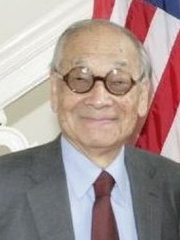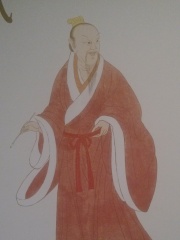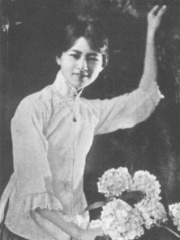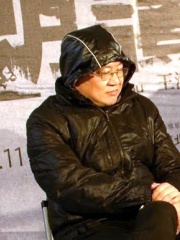



The Most Famous
ARCHITECTS from China
This page contains a list of the greatest Chinese Architects. The pantheon dataset contains 424 Architects, 4 of which were born in China. This makes China the birth place of the 23rd most number of Architects behind Greece and Ireland.
Top 4
The following people are considered by Pantheon to be the most legendary Chinese Architects of all time. This list of famous Chinese Architects is sorted by HPI (Historical Popularity Index), a metric that aggregates information on a biography’s online popularity.

1. I. M. Pei (1917 - 2019)
With an HPI of 66.41, I. M. Pei is the most famous Chinese Architect. His biography has been translated into 82 different languages on wikipedia.
Ieoh Ming Pei ( YOH ming PAY; Chinese: 貝聿銘; pinyin: Bèi Yùmíng; April 26, 1917 – May 16, 2019) was a Chinese-American architect. Born in Guangzhou into a Chinese family, Pei drew inspiration at an early age from the garden villas at Suzhou, the traditional retreat of the scholar-gentry to which his family belonged. In 1935, he moved to the United States and enrolled in the University of Pennsylvania's architecture school, but quickly transferred to the Massachusetts Institute of Technology. Unhappy with the focus on Beaux-Arts architecture at both schools, he spent his free time researching emerging architects, especially Le Corbusier. After graduating, he joined the Harvard Graduate School of Design (GSD) and befriended the Bauhaus architects Walter Gropius and Marcel Breuer. In 1948, Pei was recruited by New York City real estate magnate William Zeckendorf, for whom he worked for seven years before establishing an independent design firm, I. M. Pei & Associates, in 1955. In 1966, that became I. M. Pei & Partners, and became Pei Cobb Freed & Partners in 1989. Pei retired from full-time practice in 1990. In his retirement, he worked as an architectural consultant primarily from his sons' architectural firm Pei Partnership Architects. Pei's first major recognition came with the Mesa Laboratory at the National Center for Atmospheric Research in Colorado (designed in 1961, and completed in 1967). His new stature led to his selection as chief architect for the John F. Kennedy Library in Massachusetts. He went on to design Dallas City Hall and the East Building of the National Gallery of Art. He returned to China for the first time in 1975 to design a hotel at Fragrant Hills and, fifteen years later, designed Bank of China Tower, Hong Kong. In the early 1980s, Pei was the focus of controversy when he designed a glass-and-steel pyramid for the Louvre in Paris. He designed the Morton H. Meyerson Symphony Center in Dallas, the Miho Museum in Japan, Shigaraki, near Kyoto, and the chapel of the junior and high school: MIHO Institute of Aesthetics, the Suzhou Museum in Suzhou, Museum of Islamic Art in Qatar, and the Grand Duke Jean Museum of Modern Art in Luxembourg. Pei won prizes and awards in the field of architecture, including the AIA Gold Medal in 1979, the first Praemium Imperiale for Architecture in 1989, and the Lifetime Achievement Award from the Cooper-Hewitt, National Design Museum, in 2003. In 1983, he won the Pritzker Prize, which is sometimes referred to as the Nobel Prize of architecture.

2. Yan Liben (600 - 673)
With an HPI of 55.01, Yan Liben is the 2nd most famous Chinese Architect. His biography has been translated into 18 different languages.
Yan Liben (Chinese: 閻立本; pinyin: Yán Lìběn; Wade–Giles: Yen Li-pen) (c. 600 – 14 November 673), formally Baron Wenzhen of Boling (博陵文貞男), was a Chinese architect, painter, and politician during the early Tang dynasty. His most famous work, possibly the only genuine survival, is the Thirteen Emperors Scroll. He also painted the Portraits at Lingyan Pavilion, under Emperor Taizong of Tang, commissioned in 643 to commemorate 24 of the greatest contributors to Emperor Taizong's reign, as well as 18 portraits commemorating the 18 great scholars who served Emperor Taizong when he was the Prince of Qin. Yan's paintings included painted portraits of various Chinese emperors from the Han dynasty (202 BC–220 AD) up until the Sui dynasty (581–618) period. His works were highly regarded by the Tang writers Zhu Jingxuan and Zhang Yanyuan, who noted his paintings were "works among the glories of all times". From the years 669 to 673, Yan Liben also served as a chancellor under Emperor Taizong's son Emperor Gaozong (r. 649–683). A record of 1120 gives 42 titles of Yan's paintings, though the Thirteen Emperors Scroll is not among them. Only four Buddhist subjects are listed, against 12 Daoist. The remainder are portraits, "gods of the planets and constellations" or records of events at court. Of the surviving works attributed to him, the Thirteen Emperors Scroll is "the first that is generally accepted as being partly original", though much of it seems later. A similar figure of an emperor in fresco in the Mogao Caves (Cave 200), might be by the same hand, and carries the appropriate date of 642. By tradition the reliefs of the six favourite horses at the mausoleum of Emperor Taizong (d. 649) were designed by Yan Liben, and the relief is so flat and linear that it seems likely they were carved after drawings or paintings. Yan Liben is documented as producing other works for the tomb, a portrait series that is now lost, and perhaps designed the whole structure.

3. Lin Huiyin (1904 - 1955)
With an HPI of 51.19, Lin Huiyin is the 3rd most famous Chinese Architect. Her biography has been translated into 21 different languages.
Lin Huiyin (Chinese: 林徽因, born 林徽音; pinyin: Lín Huīyīn; known as Phyllis Whei Yin Lin when in the United States; 10 June 1904 – 1 April 1955) was a Chinese architect, writer, and poet. She is known to be the first female architect in modern China and her husband is the famed "Father of Modern Chinese Architecture" Liang Sicheng, both of whom worked as founders and faculty in the newly formed Architecture Department of Northeastern University in 1928 and, after 1949, as professors in Tsinghua University in Beijing. Liang and Lin began restoration work on cultural heritage sites of China in the post-imperial Republican Era of China, a passion which she would pursue to the end of her life. The American artist Maya Lin is her niece.

4. Wang Shu (1963 - )
With an HPI of 47.69, Wang Shu is the 4th most famous Chinese Architect. His biography has been translated into 32 different languages.
Wang Shu (Chinese: 王澍, born 4 November 1963) is a Chinese architect based in Hangzhou, Zhejiang Province. He is the dean of the School of Architecture of the China Academy of Art. With his practice partner and wife Lu Wenyu, he founded the firm Amateur Architecture Studio. In 2012, Wang became the first Chinese citizen to win the Pritzker Prize, the world's top prize in architecture. The award was the subject of some controversy since the Pritzker committee did not also award Lu Wenyu, his wife and architectural partner, despite their years of collaboration.
Pantheon has 4 people classified as architects born between 600 and 1963. Of these 4, 1 (25.00%) of them are still alive today. The most famous living architects include Wang Shu. The most famous deceased architects include I. M. Pei, Yan Liben, and Lin Huiyin.







